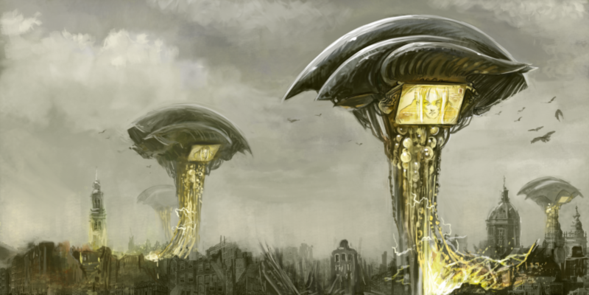Science Fiction and the Human Condition
In his latest story, SDSU nuclear physicist and sci-fi author Calvin W. Johnson writes about the working-class heroes responsible for futuristic technology.

The Curious Aztec takes you behind the scenes of scientific investigation and discovery taking place at San Diego State University.
The key to writing good science fiction, according to SDSU nuclear physicist and author Calvin W. Johnson, is not to get too carried away with the promise of your invented technology. If your shiny new scientific advancement fixes all the world’s problems, you’ve written yourself right out of an interesting story.
“H.G. Wells said something like, and I’m paraphrasing here, ‘When everything is possible, everything is boring,’” Johnson said. “The technology in your stories needs to have limits. So, you can go faster than the speed of light—but people still die of cancer.”
The border between super-technology and its human cost is the setting of Johnson’s latest futuristic short story, “The Anomaly,” which is featured as the cover story of the latest issue of Analog Science Fiction & Fact. In it, Johnson explores the harsh lives of slave-laborers who build the parts that make possible a futuristic (yet scientifically plausible) space-travel technology known as “neutrino surfing.”
The idea for it derived from a previous story he had written about these neutron surfers spanning the galaxy (which itself derived from research he did in graduate school on neutron stars). Eventually he got to thinking about the enormous amount of human toil and sacrifice it would require to create and sustain such a technology.
Cost of technology
At the beginning of “The Anomaly,” Johnson’s then-illiterate protagonist has lived underground his entire life, has never seen the sky, and hasn’t even the faintest clue that he and others of his caste are building the parts and handling the dangerous materials that enable interstellar travel.
Of course, from there it’s not such a far leap to thinking about less-privileged workers in our own world who make parts for iPhones and televisions. By focusing on these often overlooked protagonists in his story, Johnson hopes to undercut the trope that those with access to superior technology and learning are the only ones with stories worth telling.
“It’s important to remember that a lot of our advantages come at the expense of other people,” he said.
Johnson’s dual interests in science and fiction developed alongside one another as a youngster.
“When I was a kid, lasers and atoms and nuclear reactors seemed really cool,” he said. “And in the fifth grade, I had a teacher who read us ‘The Hobbit’, and from then on I was hooked on fantasy and sci-fi.”
Eventually, Johnson became a professional nuclear physicist whose work largely deals with using computer algorithms to figure out the structure of atomic nuclei. But along the way, he never lost his interest in writing.
Student of science, fiction
While an undergraduate at the University of California, Davis, Johnson took classes taught by iconic science fiction author Kim Stanley Robinson. Later, as a graduate student at the University of Washington, he took more classes with the late feminist science fiction author Joanna Russ.
Over the course of his writing career, Johnson has had about 14 science fiction short stories published as well as two dozen or so poems.
You might imagine that being a nuclear physicist would help him when it comes to writing science fiction—or bother him when he reads it—but Johnson argued that complete scientific accuracy isn’t as important as you might think.
“I might have a little more scientific literacy in my work, but when I read science fiction, I’m not bothered by scientific errors unless I feel like it’s lazy writing, that it’s something the author should have known or bothered to find out,” he said. “For me, it’s much more about the story and about the attitude toward science.”



